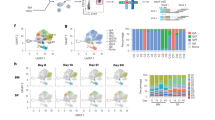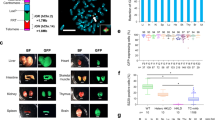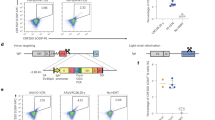Abstract
ANTIBODIES are usually prepared from recently boosted animals and reflect ongoing immune responses1–6. In humans, this is restrictive as ethical constraints generally prevent antigen-boosting. Therefore the rich memory compartment of human antibody responses remains largely untapped7. Severe combined immune deficiency (SCID) mice8 populated with human cells9–11allow the stimulation of human antibody memory without the usual constraints. Here we show how peripheral blood lymphocytes can be stimulated by antigen to produce large secondary responses after transfer to SCID mice. Specific monoclonal human Fab fragments can then be isolated from the mice by repertoire cloning even when the human donor's last contact with antigen was more than 17 years ago.
This is a preview of subscription content, access via your institution
Access options
Subscribe to this journal
Receive 51 print issues and online access
$199.00 per year
only $3.90 per issue
Buy this article
- Purchase on Springer Link
- Instant access to full article PDF
Prices may be subject to local taxes which are calculated during checkout
Similar content being viewed by others
References
Winter, G. & Milstein, C. Nature 349, 293–299 (1991).
James, K. & Bell, G. T. J. Immunol. Meth. 100, 5–40 (1987).
Persson, M. A. A., Caothien, R. H. & Burton, D. R. Proc. natn. Acad. Sci. U.S.A. 88, 2432–2436 (1991).
Caton, A. J. & Koprowski, H. Proc. natn. Acad. Sci. U.S.A. 87, 6450–6454 (1990).
Caton, A. J. & KoprowsKi, H. Proc. natn. Acad. Sci. U.S.A. 88, 1590 (1991).
Burton, D. R. Trends Biotechnol. 9, 169–175 (1991).
Lerner, R. A., Barbas, C. F. III, Kang, A. S. & Burton, D. R. Proc. natn. Acad. Sci. U.S.A. 88, 9705 (1991).
Bosma, G. C. Custer, R. P. & Bosma, M. J. Nature 301, 527–530 (1983).
McCune, J. M. et al. Science 241, 1632–1639 (1988).
Mosier, D. E. Gulizia, R. J., Baird, S. M. & Wilson, D. B. Nature 335, 256–259 (1988).
Mosier, D. E., Bulizia, R. J., Baird, S. M. & Wilson, D. B. Nature 338, 211 (1989).
Bankert, R. B. et al. Curr. Topics Microbiol. Immun. 152, 201–210 (1989).
Tighe, H. et al. Eur. J. Immun. 20, 1843–1848 (1990).
Krams, S. M., Dorshkind, K. & Gershwin, M. E. J. exp. Med. 170, 1919–1930 (1989).
Milich, D. R. & McLachlan, A. Science 234, 1398–1401 (1986).
Tiollais, P., Pourcel, C. & Dejean, A. Nature 317, 489–495 (1985).
Milich, D. R., McLachlan, A., Thornton, G. B. & Hughes, J. L. Nature 329, 547–549 (1987).
Seppälä, I. J. T., Routonen, N., Sarnesto, A., Mattila, P. A. & Mäkelä, O. Eur. J. Immun. 14, 868–875 (1984).
Huse, W. D. et al. Science 246, 1275–1281 (1989).
Clackson, T., Hoogenboom, H. R., Griffiths, A. D. & Winter, G. Nature 352, 624–628 (1991).
Barbas, C. F. III, Kang, A. S., Lerner, R. A. & Benkovic, S. J. Proc. natn. Acad. Sci. U.S.A. 88, 7978–7982 (1991).
Hansen, T. H. & Sachs, D. H. in Fundamental Immunology (ed. Paul, W. E.) 445–487 (Raven, New York, 1989).
Cannon, M. J., Pisa, P., Fox, R. I. & Cooper, N. R. J. clin. Invest. 85, 1333–1337 (1990).
Bosma, G. C. et al. J. exp. Med. 167, 1016–1033 (1988).
Duchosal, M. A., McConahey, P. J., Robinson, C. A. & Dixon, F. J. J. exp. Med. 172, 985–988 (1990).
Valenzuela, P. et al. Nature 280, 815–819 (1979).
Galibert, F., Mandart, E., Fitoussi, F., Tiollais, P. & Charnay, P. Nature 281, 646–650 (1979).
Pasek, M. et al. Nature 282, 575–579 (1979).
Stahl, S., MacKay, P., Magazin, M., Bruce, S. A. & Murray, K. Proc. natn. Acad. Sci. U.S.A. 79, 1606–1610 (1982).
Williamson, R. A., Persson, M. A. A. & Burton, D. R. Biochem. J. 277, 561–563 (1991).
Author information
Authors and Affiliations
Rights and permissions
About this article
Cite this article
Duchosal, M., Eming, S., Fischer, P. et al. Immunization of hu-PBL–SCID mice and the rescue of human monoclonal Fab fragments through combinatorial libraries. Nature 355, 258–262 (1992). https://doi.org/10.1038/355258a0
Received:
Accepted:
Issue Date:
DOI: https://doi.org/10.1038/355258a0
This article is cited by
-
Generation of primary antigen-specific human T- and B-cell responses in immunocompetent SCID-hu mice
Nature Medicine (2000)
-
Potential therapeutic use of antibodies directed towards HuIFN-γ
Biotherapy (1997)
-
In vivo immunosuppression by targeting a novel protease receptor
Nature (1996)
-
Efficient production of IGG human monoclonal antibodies by lymphocytes stimulated by lipopolysaccharide, pokeweed mitogen, and interleukin 4
In Vitro Cellular & Developmental Biology - Animal (1996)
-
Development of human monoclonal antibodies: A review
Cytotechnology (1996)
Comments
By submitting a comment you agree to abide by our Terms and Community Guidelines. If you find something abusive or that does not comply with our terms or guidelines please flag it as inappropriate.



